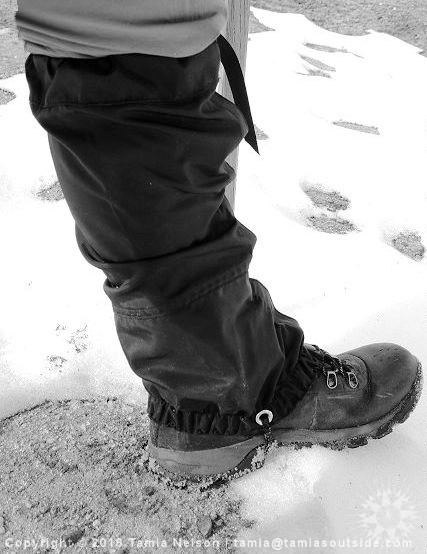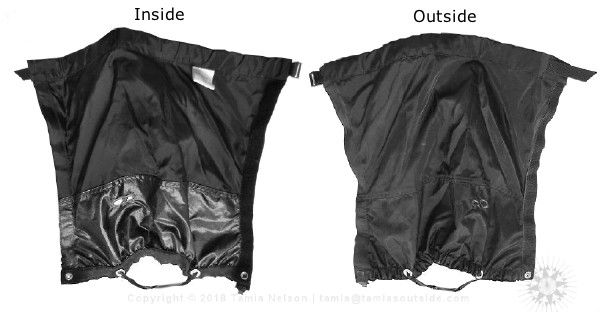The gulf between boots and pants looms large in cold weather, but gaiters can bridge the gap with ease. But they’re not only good at keeping out the cold, as Tamia points out.
______________________________
by Tamia Nelson | April 20, 2018
Lug-soled boots are my first choice for winter footwear when I’m not using snowshoes or skis. An aggressive tread and the support that only stiff uppers can give improve the odds that each step will be sure-footed. But there is a problem with hiking and mountaineering boots. They don’t rise above the ankles, and this leaves the lower leg vulnerable to soiling and wetting, not to mention cold. No matter. I have gaiters. They’re not exactly a new idea, either. Backcountry and high country trekkers have worn them for generations. Townsmen used to wear them also. )Sam Weller, the cheerful cockney who rescued Charles Dickens’ Pickwick Papers from obscurity, was described as “wearing light breeches and gaiters.”)
So gaiters have stood the test of time. Little more than a fabric tube that reaches from ankle to knee (though some gaiters do no more than cover the ankle), gaiters protect your shins from wet, wind, and cold, while they leave your boot soles free to do what they do best—come to grips with the terrain. I’ve had my present gaiters for over a decade, bought on the cheap at a discount sale at Campmor. They were available in “one size fits most,” and luckily, that includes me. They have a full-length velcro closure up the front, which makes it easy to put them on and take them off.

A doubled nylon cord slips under the instep of my boots to stop the gaiters from riding up, and a lace hook on the lower hem secures to a bootlace. This keeps the front of each tube from scooping up samples of whatever I happen to be walking through. Want the inside story? Then check this out:

You may have noticed that the lower portion of each gaiter—that’s the bit that covers the ankle and boot top—is made of coated waterproof fabric. The balance of the gaiter is breathable nylon packcloth. A snap secures the elasticized lower hem; an adjustable buckle keeps the gaiter from falling down.
That’s it. But as simple as gaiters are, they’re still mighty handy. In winter, they keep snow out of your boots, and they blunt the icy wind’s cutting edge. (If you wear knickers, rather than long pants, this is doubly welcome.) In summer, they protect your legs from brambles, thorns, mud, and ticks. But they’re no substitute for waders, wellies, or proper overboots if you’re planning on fording streams
How much will all this utility cost you? Well, I paid around USD20 for mine about 15 years ago. You’ll probably pay more now, especially if you want gaiters made from some waterproof-but-breathable miracle fabric, but I’m not convinced that it’s worth it. And while getting a good fit isn’t often a problem, folks with very muscular calves, very long (or very short) legs, or bulky boots may need to shop around a bit.
Gaiters are simple and good—the twin touchstones of utilitarian gear. So if you’re thinking of wandering around in the winter woods, give gaiters a try. I doubt you’ll be disappointed.

